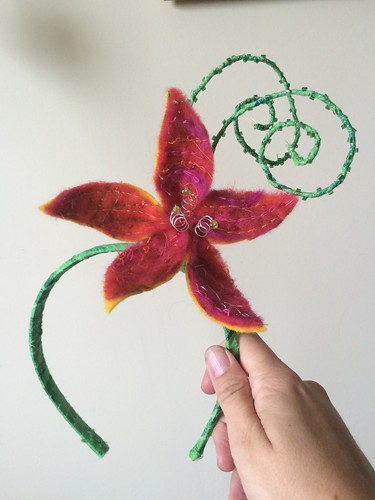As with most of my work I spent a lot of time thinking about what I was going to make without actually achieving a thing! I contemplated making a brooch, a facinator, a headband and a crazy hat. In the end I settled on a headband/facinator as I had recently been to a wedding and found that I wished I had bought one for the event!
I stayed with the module colours of orange/red and green and decided to make the fabric that I would use from felt.
Image 1 - Design worksheet:

Image 2 - Carding the felt to blend together yellow and orange:

Image 3 - Laying out the felt tops on a tray (I decided to 'do' my felting the 'quick and dirty' way which involved covering it over with a piece of net, saturating with soapy water and rubbing throughly):

Image 4 - first layer on my vintage tray (ha!):

Image 5 - More layers and the addition of threads:

Image 6 - Felt with silver thread in:

Image 7 - Felt with threads and sequins:

Image 8 - The felt I chose to use:

Image 9 - Hand embroidery on felt (which has been backed with manufacturered yellow felt):

Image 10 - Petal templates overlaid onto felt:

Image 11 - Curling silver wire:

Image 12 - Cut petals and wires with beads held together (before sewing) to see what they looked like:

Image 13 - I considered revertering to a brooch for a while but decided a headband would be better. Here I have temporarily attached spirals of wire (which were actually from an old notebook - wrapped in green fabric (from earlier in the module) and silver wire with beads sewn on) using thick wire and I then I wrapped them with thread and sewed them onto the band:

Image 14 - Finished headband/fascinator:

Image 15 - Close up of the wire spirals:

Image 16 - The band which has been wrapped in fabric:

Image 17 - Close up of the flower:

Image 18 - The fascinator/headband as modelled by the lovely Emily Stevens:

I'm quite happy with the outcome but now I have to make a box to house my fascinator in as it's not the easiest thing to store!


















































